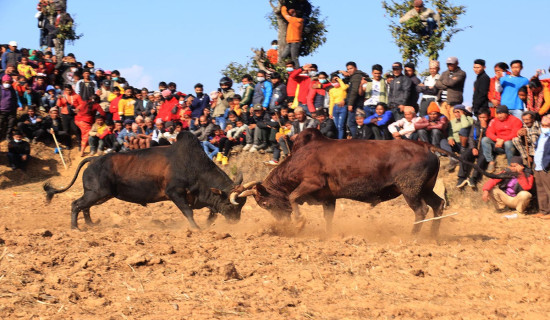- Friday, 16 January 2026
Ensure Sustainable Hydropower Generation
For a cash-strapped country like Nepal, hydropower holds the potential for economic development. Nepal is rich in water resources. There are over 6,000 rivers across the country. As per a study conducted by the World Bank, the country has the potential to generate 83,000 megawatts of electricity and around 44,000 megawatts of electricity is technically feasible to generate. As per a study conducted in 2019 by the Water and Energy Commission Secretariat on how ten rivers, including the Gandaki, Koshi and Karnali, could be tapped for hydroelectricity, irrigation and drinking water by 2050, the gross hydropower potential is 72,544 megawatts, with the major rivers - Gandaki, Koshi and Karnali - accounting for 94 per cent of the gross potential. The country has now 2,800 megawatts of installed capacity. This goes on to show that the country can generate much more electricity in the days ahead.
The Pharping Hydropower Plant with a capacity for generating 500 kilowatts of electricity is the first hydel plant in Nepal. Until 1960, the country had an installed capacity of 1.1 megawatts, which grew to 556.8 megawatts by 2005. For many years after the installation of the first hydropower plant at Pharping, the country could not make any remarkable headway in the hydropower sector. The 10,800 MW Karnali Chisapani Multipurpose Project was conceived in the 1960s. Likewise, the study of the West Seti Hydropower Project was conducted in the early 1980s. Both of these projects are yet to be developed.
Setback
During the Panchayat regime, there was a state-controlled model of economic development. The private sector was not encouraged to undertake any development projects, be it hydropower or otherwise. With Nepal adopting economic liberalisation policy during the 1990s, the private sector has been involved in hydropower and other sectors. It would be pertinent to mention that the 300 MW Arun III Hydropower Project to be financed by the World Bank had to be revoked amid protests by political parties, which is a setback in the hydropower sector.
In recent times, there has been remarkable headway in the hydropower sector. The government has formulated various strategies for developing hydropower in the country. The strategies focus on increasing generation of electricity, increasing domestic consumption and exporting surplus electricity to neighbouring countries. As per the 12-year plan of the government, domestic consumption will be increased from 380 units in 2023 to 1,500 units by 2035. The government has a target of generating 28,000 megawatts of electricity by 2035. Out of this, 15,000 megawatts of electricity is planned to be exported.
Now more than 95 per cent of population had an access to electricity. It is imperative to provide reliable grid-supplied electricity so as to spur economic development and contribute to poverty alleviation. Generation of electricity in Nepal is erratic. There is excess generation of electricity during the wet season, while there is a shortage during the dry season. This is because of most of the hydel projects being run-of-the-water types. Reservoir-based hydel projects are required for the sustainable generation of electricity. Nepal first generated surplus electricity in August 2021 when the 456 MW Upper Tamakoshi Hydropower Project went into full operation. Since then, the country has been able to generate surplus electricity. However, the country has to depend on imports from India to overcome the shortage of electricity during the dry season.
In 2021, India agreed to purchase 39 megawatts of electricity from India: 24 megawatts from the Trishuli Hydropower Plant and 15 megawatts from the Devighat Hydropower Plant. Nepal and India agreed to cooperate in the energy sector at the sub-regional level of the BBIN (Bangladesh, Bhutan, India and Nepal) initiative through a joint vision statement signed in April 2022. During Prime Minister Pushpa Kamal Dahal Prachanda’s visit to India in May-June 2023, India promised to purchase 10,000 megawatts of electricity in 10 years.
Although transactions in electricity between Nepal and India are going on, the country has to conduct such transactions on the terms and conditions as dictated by its southern neighbour. India has said in clear terms that it will not purchase electricity generated by Chinese-funded hydel projects. However, India has agreed to facilitate the export of 40 megawatts of electricity from Nepal to Bangladesh through existing transmission lines.
Bright prospects
Nepal has bright prospects of generating surplus electricity. For this, reservoir-based hydel projects need to be prioritised. The private sector should be further encouraged to generate electricity. Foreign investments should also be invited to develop huge hydel projects. The country lacks resources to develop huge hydel projects. In this regard, unnecessary political interference should be steered clear of. Domestic consumption of electricity should also be accelerated. Households should be encouraged to use electric appliances. But for this, electricity supply should be regular. Likewise, electric transport, both private and public, should be accorded priority. The East-West Railway, whose construction is progressing although a bit slowly, needs to be completed soon.
Use of electricity on transport has many advantages. The country has to spend billions of rupees on the import of petroleum products from India every year. In fact, spending on petroleum products alone exceeds the amount of exports. By increasing domestic consumption of electricity and by boosting electricity exports, the trade deficit can be retrenched. Further, use of electricity instead of fossil fuels helps the country reduce carbon footprints by reducing air pollution. Moreover, development in the hydropower sectors stimulates economic growth, creates jobs, alleviates poverty and contributes to uplifting the standard of living of poor people. It will have a positive effect on external trade and the balance of payments. Imports of electricity from India can also be eliminated or at least minimised.
(Maharjan has been regularly writing on contemporary issues for this daily since 2000.)
















